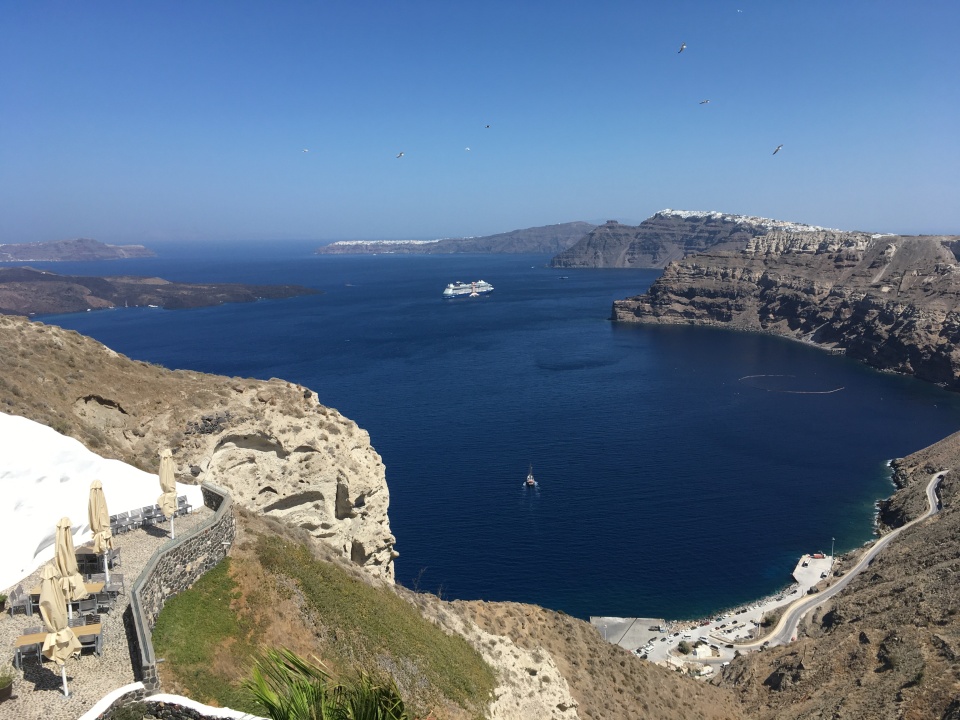Shaped by ancient volcano, Greek Island Santorini an Instagramer’s paradise

Santorini’s vast 8-by-5-mile volcanic caldera dwarfs the 14-deck Celebrity Apex anchored off shore. A serpentine road winds down to the sea in the foreground as white-washed village houses frost distant clifftops. (Janet Podolak)
The scope of the volcano that formed today’s Santorini is almost incomprehensible. Standing on the rim of the onetime crater high above the sea on the Greek island makes an indelible impression not transmissible in photos.
Our ship, the Celebrity Apex, was anchored in the 8-by-5-mile caldera blasted out by that volcano some 3,600 years ago, that devastated the Minoan settlements of Akrotiri and nearby islands. That crater then was flooded by the Aegean Sea.
Viewed from a winery 1,500 feet up at the edge of the caldera, the 14-deck ship looked like a toy boat not far from a small island where the nascent volcano still smolders.
Trucks far below on the serpentine roadway snaking down the cliff also looked like miniature toys.
One of the distant clifftops appears to be frosted with snow. However, what you’re seeing are the white-washed houses of Fira, the island’s major town, accessed from the coast by a gondola cable car, by foot, or astride a donkey. A closer look shows the footpath and its stairs zigzagging back and forth across the face of the cliff, striped with colored layers of lava that formed it over eons of eruptions. The 588 stairs are numbered down to the water.
We’d been tendered ashore from the ship to the flatter eastern side of the island, where we met our guided shore excursion to take us to see Santorini’s highlights.

Those tasting Santorini’s Assyrtiko wines at Venetsanos Winery have a view of a twisty road leading to the shore. (Janet Podolak)
After the long-ago volcano, it was more than 300 years before the island, then called Thira, could support settlement by humans. But today, reborn as Santorini, it’s one of the most visited among all the Greek islands in the Mediterranean. It’s also one of the most expensive — for meals, lodging and souvenirs.
In a recent post, I wrote about Akrotiri, a Bronze Age Santorini city buried by volcanic ash in that volcano.
Consider that Akrotiri’s people were as ancient to the Romans as the Romans are to us.
Many artifacts from its excavation are displayed in Fira at the Museum of Prehistoric Thira and at the National Archaeological Museum in Athens.
Throughout the island, blue-roofed domes of Greek Orthodox churches are framed by cube-shaped white-washed stucco homes and other structures. With a canopy of blue skies overhead and the bright blue caldera as the backdrop, they’re the most sought after and Instagram-worthy views of Santorini.
Visitors crowd the labyrinth pedestrian lanes of the village of Oia to shop, take in the views, capture the iconic photographs and to stake out a place to view the storied sunset over the caldera. Guidebooks advise avoiding the July and August crowds with a visit in October or May, but we were there in the summer on a shore excursion from the Celebrity Apex.
The whitewashed homes, we learned, help keep interiors cooler in the blazing heat. Outdoor ovens are seen on many patios because cooking is done largely outdoors, in both summer and winter. Only 15 inches of rain falls each year, so drinking water must be purchased and is brought by boat from Athens.
At the time of my July visit, it was 113 degrees with very little shade. So-called cave houses, dug into the sides of the cliffs, once housed those who could not afford to build a house. But today they are pricey lodgings and homes for the wealthy.
Despite Santorini’s timeless appearance, many island structures were destroyed in a huge 1956 earthquake that preceded the last volcanic eruption on Santorini. Clever islanders considered the views when they rebuilt Oia, transforming it into the tourist mecca it is today. Before tourism became its major industry, the island was known for the pumice quarried to make a sturdy concrete.

Pedestrian-only cobblestone lanes lead to views of blue domed churches and sunset vantage points in the village of Oia.(Cathryn Knezevich)
Santorini, which is hot, dry and windy in the summer, is one of only two places in Europe classified as having a desert climate. And the crops that grow here — grapes, cherry tomatoes, cucumbers and eggplant — are never watered.
Clouds, captured overnight by the steep terrain, leave a layer of dew on the ground that keeps them growing in the rich volcanic soil. Their sweetness transmits to dishes served in many of the restaurants.
The island’s Assyrtiko grapes are a varietal growing tucked inside vines coiled into a round basket shape to protect them from the strong sunlight. The pumice in the earth absorbs the morning dew and distributes it to the roots. The dry, white and minerally Assyrtiko wine I procured from World Wines and Liquor in Mentor,Ohio gave me a taste of Santorini before I left home.

Grapevines are wound into basket-like clusters to protect wine grapes from Santorini’s fierce sun. (Janet Podolak)
Our group’s shore excursion stopped at the Venetsanos Winery, where we enjoyed a tasting of three wines on a shady terrace with gorgeous views over the caldera — where some of today’s photos were shot. It’s a good place to reserve a table for sunset to avoid the crowds in Oia.

Steep labyrinthian lanes, often crowded with visitors, define the shopping experience in the village of Oia. (Cathryn Knezevich)




Recent Comments